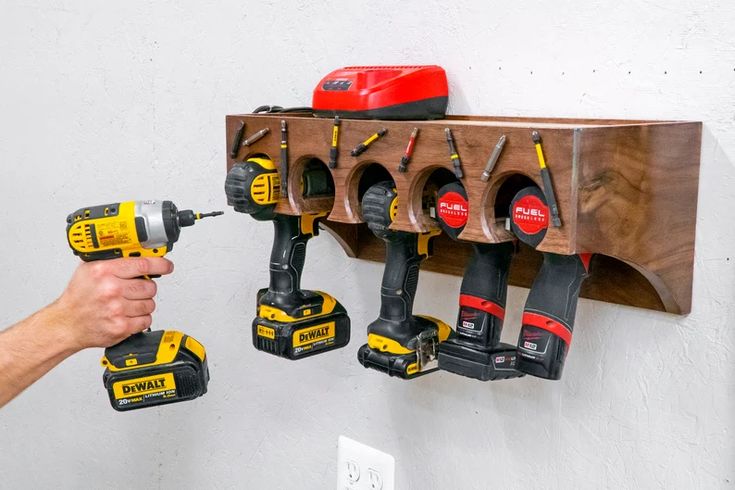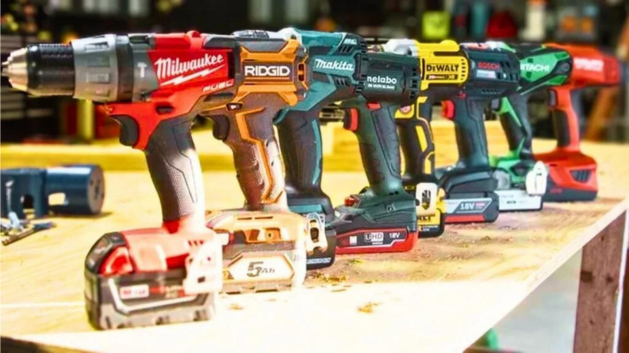Cordless tools have all but replaced their corded counterparts, and for good reason. No straddling cables are risking your safety, tools have comparable, if not more power, are compact and lightweight and can be used anywhere. You don’t need nearby power sockets or extension cords to get them working. That issue is solved with powerful rechargeable batteries and efficient brushless motors with long run times to get the job done.
The first cordless drill was introduced by Black and Decker more than 60 years ago, but was not available to the wider public and soon discontinued. Early tools were underpowered, had dismal battery life, were plagued with dozens of safety issues, and were a hard sell compared to corded tools’ dependability. A lot though has changed in the past few decades, with most major tool brands now switching their entire lineups to cordless. This is largely due to the advancements in battery technology, shorter charging times, the power and efficiency of brushless motors, and the reductions in size and weight. These are not the only reasons all tradies now choose cordless tools over older tech.
Benefits of Going Cordless

- Portability – since there are no cords or the need for nearby power sockets, cordless tools are portable and offer flexibility for any project or work setting. Design changes have also meant lower weight and improved ergonomics for easy use.
- Safety – trips from power tool cords are some of the most frequent workplace accidents, so going cordless also improves safety. No straddling cords also increase available space and make maneuvering in tighter areas easier.
- High power ratings – batteries now offer extended run times, but the advancements with efficient and powerful brushless motors are a real game-changer. There’s more than enough voltage to run even the most demanding tools.
- Storage options – tool makers package their products in tough, easy-to-carry cases, with room for batteries, chargers and any extras. The convenience also extends to larger carry cases and systems, allowing working professionals to have everything organised, protected and easily transported.
Choosing the Right Tools

If you’re just stepping into the cordless world, choosing tools for pro use will take some consideration. The same applies to small home repairs or anything that meets your craving for DIY projects. However, the transition from corded to cordless doesn’t have to be hard. Here are a few tips to consider so you don’t regret your purchase:
Going with the Right Tool Brand
The same brands that offered reliable corded tools for decades now have the same or extended cordless lineup with even more options. This covers typical areas like automotive, metal and woodworking, repairs and construction, but also tools used in gardening and landscaping, such as blowers and trimmers. All major brands – Makita, Milwaukee, Bosch, DeWalt and even nailgun specialists Paslode – have a detailed selection to cover most applications. Tools are offered in general-use and professional tiers, with several options. They are also supplied with accessories, including blades, chisels, grinding discs etc to match the intended use. And they’re paired with corresponding batteries and chargers to suit power output and the required run times.
Brand competition is pushing the limits of what’s possible and driving innovation with proprietary tech. This is a boon for anyone looking to buy cordless tools. Lithium-ion batteries last for a typical workday, efficient motors spin at higher speeds, and advanced electronics reduce power usage. Recharging batteries is also much faster.
Choosing a brand is more about personal preference, but you may be inclined to purchase a tool with better specs, improved usability or lower weight to meet your needs. Differences are slight, but consistent advancements in features, power ratings, and safety may mean you choose tools from one brand over another.
Buying ‘Bare’
Buying into a brand is buying into an ecosystem. If you already have a few tools from the same brand and are equipped with compatible batteries and chargers, then buying bare, or the tool by itself, means substantial savings.
The Benefit of Combo Kits
To lure buyers, brands are now offering combo kits, with a varying number and types of tools. This can be a single tool with a charger and battery, or kits consisting of up to 15 separate tools, plus the addition of carry cases, and all the required extras. For anyone doing the major switch from corded to cordless, this is the way to save a lot of cash and have everything needed for the job. Kits can also be packaged with tools for specific lines of work for even more convenience.
Battery and Charger Tech
All cordless tool brands are investing a lot of R&D into getting the most out of their batteries. The move has been from simple 12V batteries a few years ago to battery packs in 40, 54 and even 64V for power-hungry products like mitre saws, hammer drills or lawnmowers. 18V batteries are the standard offering for tools like drills and impact wrenches, with variants available in different amperage hours for normal or extended run times.
Batteries are also getting smaller and lighter, have improved electronics to allow for temperature extremes, and can be depleted completely without damage. Many previous issues, like self-discharging or overheating, are now a thing of the past.
Lastly, chargers too have seen considerable improvements. They can get fully flat batteries to 80 per cent charge within minutes, or charge multiple batteries in a single go. And like batteries, there are quite a few types to choose from.


